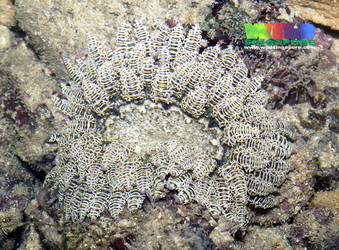Phymanthus
- Actinodendron loligo H. and E. Ehrenberg 1834
- Actinia crucifer Leseur 1817
- Phymanthus sansibaricus Carlgren 1900
- Phymanthus Strandesi Carlgren 1900
- Phymanthus pinnulatum Martens (see Klunzinger 1877)
- Thelaceros rhizophoreae Mitchell 1890
- Phymanthus laevis Kwietniewski 1898
- Phymanthus buitendijki Pax 1924
- Phymanthus muscosus Haddon and Shackleton 1893
- Actinia coeruleus Quoy and Gaimard 1833
- Phymanthus simplex Haddon and Shackleton 1893
- Ragactis pulcra [sic] Andres 1883
Characteristics
Phymanthidae with base and column of variable appearance. Upper part of column with verrucae, which sometimes may be indistinct. A row of perforated marginal pseudospherules (always?). Cinclides may be present at the base. No sphincter or a very weak, diffuse one. Marginal tentacles arranged hexa- or octomerously [sic]. Laterally the marginal tentacles are provided with weak or well developed protuberances in the form either of low knobs or of ramified branches. The discal tentacles sometimes resemble the marginal tentacles in part, more usually they are papilliform, sometimes very indistinct or even wholly absent? Longitudinal muscles of tentacles and radial muscles of oral disc ectodermal, sometimes with a slight tendency to be meso-ectodermal. Pairs of mesenteries arranged hexa- or octomerously [sic], many are perfect, the stronger with or without the directives, fertile. Retractors well developed, strong, diffuse or strongly restricted, reniform. Cnidom: spirocysts, basitrichs, microbasic p-mastigophors.References
Carlgren, O. 1949. A Survey of the Ptychodactiaria, Corallimorpharia and Actiniaria. Kungl. Svenska Vetenskapsakadamiens Handlingar, series 4, volume 1, number 1.
Title Illustrations

| Scientific Name | Phymanthus sp. |
|---|---|
| Location | Bukit Merah, Central Singapore |
| Specimen Condition | Live Specimen |
| Source | Frilly sea anemone (Phymanthus sp.) |
| Source Collection | Flickr |
| Image Use |
 This media file is licensed under the Creative Commons Attribution-NonCommercial-NoDerivs License - Version 2.0. This media file is licensed under the Creative Commons Attribution-NonCommercial-NoDerivs License - Version 2.0.
|
| Copyright | © 2005 Ria Tan |
About This Page
The information provided on this page is based on Oscar Carlgren's 1949 catalog.Copyright © 1949 Swedish Academy of Sciences.
Please note that Carlgren's text contains a number of errors, and much of the information is now out of date. An update of the catalog is currently under preparation in Daphne Fautin's laboratory, and the results of this work will be incorporated in future versions of this page.
Keyboarding of Carlgren's catalog was done as part of a project to create an electronic database of the sea anemones of the world, funded by NSF Grant DEB9521819, awarded to Daphne G. Fautin. This grant is in the program Partnerships to Enhance Expertise in Taxonomy (PEET). Susanne Hauswaldt, Katherine Pearson, and April Wakefield-Pagels contributed to the keyboarding effort.
Correspondence regarding this page should be directed to Daphne G. Fautin at
Page copyright © 2000
All Rights Reserved.
Citing this page:
Tree of Life Web Project. 2000. Phymanthus. Version 01 January 2000 (temporary). http://tolweb.org/Phymanthus/18719/2000.01.01 in The Tree of Life Web Project, http://tolweb.org/








 Go to quick links
Go to quick search
Go to navigation for this section of the ToL site
Go to detailed links for the ToL site
Go to quick links
Go to quick search
Go to navigation for this section of the ToL site
Go to detailed links for the ToL site